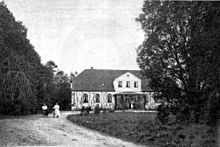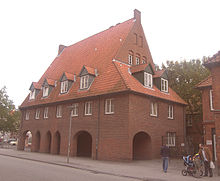Marienwohlde Monastery
The Marienwohlde monastery was a Birgitten monastery on the Alte Salzstrasse in what is today the municipality of Lankau, not far from the city of Mölln .
monastery
The double monastery Marienwohlde belonged to the order of the Redeemer founded by Birgitta von Vadstena in the 14th century . Unusually for the cultural transfer from west to east that was common in the Baltic Sea region in the Middle Ages , it was founded by nuns and monks from the Mariendal monastery near Reval, which was founded in 1407 in 1412/13 according to the Augustinian rule . Initially it was located near Bälau , but was relocated to the area of today's Lauenburg community of Lankau as early as 1413 . The monastery was located in the area of what is now the Marienwohlde estate.
The Marienwohlde monastery was located between the three rich Hanseatic cities of Hamburg , Lübeck and Lüneburg and soon enjoyed a solid economic base under special protection from Lübeck, which was also reflected in the building stock erected between 1414 and 1418 and the lands and villages belonging to the monastery. In addition to Marienwohlde, the monastery also owned Bälau, Bergrade , half a portion of the village of Breitenfelde in addition to the Lübeck portion and Pezeke , a robber knight castle north of the so-called Black Kuhle , today still called Spitzbubenbarg , which was destroyed by Lübeckers in 1343 . The monastery quickly became so wealthy that it earned interest income from credit transactions. It was one of the largest Birgitten monasteries and in 1424 it became the mother monastery of Mariakron Monastery in Stralsund . For example, Lübeck councilor Hinrich Constin († 1482) bequeathed half of the village of Duvensee and half of the lake to the monastery . The monastery church , consecrated in 1458 by Bishop Johann von Preen from Ratzeburg , had 13 altars and rich art treasures. It was the burial place of the former bishop of Lübeck Thomas Grote, who died in 1501 .
The monastery was devastated and burned down during the count's feud in 1534 by Holstein troops in the course of the occupation of the city of Mölln. The land was confiscated in 1558 by Duke Franz I von Sachsen-Lauenburg on the occasion of the Reformation , the last monastery buildings were demolished and the Marienwohlde estate was leased. A few pieces of equipment, including the mighty bronze seven-armed chandelier from 1436 and some incunabula , ended up in the Mölln Nicolaikirche , individual archaeological finds later came to the museum in Mölln. A soft-style limestone Marienkopf discovered during excavations in 1904 found its way into the collections of the Schleswig-Holstein State Museum at Gottorf Castle via the Thaulow Museum in Kiel after the Second World War . It resembles a figure of Katharina in Tiegenhagen in West Prussia, which Walter Paatz attributed to the sculptor Johannes Junge in 1920 .
Birgittenhof
As early as 1534, the nuns withdrew from the violence in the Birgittenhof at Wahmstrasse 76-86 in Lübeck. This town courtyard had belonged to them since 1439. The last abbess died there in 1573. In 1558 the monastery brought an action against Franz von Sachsen-Lauenburg before the Reich Chamber of Commerce , but in 1688 (!) It came to nothing. After the dissolution of the monastery community, the Birgittenhof was used as a residential home for unmarried women. During the air raid on Lübeck on March 29, 1942 , the remains of the courtyard, which is now a listed building, was partially destroyed. The Birgittenhof is what remains of the former Möllner monastery.
Trivia
The front building on Wahmstrasse was rebuilt in 1975. On May 5, 1980, Klaus Grabowski murdered seven-year-old Anna Bachmeier in this house. Grabowski was later shot in the courtroom by Anna's mother, Marianne Bachmeier .
literature
- Christian Nettelbladt (edited by Karl Friedrich Wilhelm von Nettelbladt ): Preliminary brief message from some monasteries of the H. Swedish Birgitte outside of Sweden, especially in Germany. Frankfurt and Ulm 1764
- Digitized copy of the copy from the Bavarian State Library
- Ernst Deecke : Marienwold Monastery in: Sachau: Patriotic archive for the Hertzogthum Lauenburg: from men who know the country , Volume 1, H. Linsen, 1857, pp. 341–398 ( digitized version )
- Reinhold Beranek: The Birgittenkloster Marienwohlde in the north of Mölln. In: Lauenburg homeland. Journal of the Heimatbund and history association Herzogtum Lauenburg. NF 146, 1997, ISSN 0724-4282 , pp. 3-52.
- Heinrich Dormeier : New branches of the order in the Hanseatic region. Lübeck foundations in favor of the Birgittenkloster Marienwohlde near Mölln , in: Oliver Auge / Katja Hillebrand (ed.): Monasteries, monasteries and convents north of the Elbe. On the current status of monastery research in Schleswig-Holstein, North Schleswig and the Hanseatic cities of Lübeck and Hamburg ; QFGSH 120 (2013); Pp. 261-366
- Werner Neugebauer : Nice Holstein. In: Lübecker Nachrichten . 1957, pp. 452/453.
- Holger Roggelin, Joachim Stüben: Orate pro patre Seghebando! On the origin and meaning of the Möllner cradle prints. In: Lauenburg homeland. Journal of the Heimatbund and history association Herzogtum Lauenburg. NF 144, 1996, pp. 40-59.
supporting documents
- ↑ also in High German: Mariental. See the Catholic Church in Estonia
- ^ Heinrich Dormeier: New branches of the order in the Hanseatic area. Lübeck foundations in favor of the Birgittenkloster Marienwohlde near Mölln , p. 263
- ↑ In 1418 the Roman-German King Sigismund granted Lübeck patronage over the monastery.
- ^ Emil Ferdinand Fehling : Lübeck Council Line. Lübeck 1925, No. 551.
- ↑ According to the art topography Schleswig-Holstein (Neumünster 1974) there are still minor traces of the monastery such as a piscine basin , a tombstone fragment and granite pillars in the manor house built in 1847 .
- ↑ Ernst Schlee: The Marienkopf from Marienwohld. In: Der Wagen 1959, pp. 51–52 with reference to Walter Paatz: The Luebeck stone sculptures in the first half of the 15th century. Lübeck 1920, p. 28 ff.
- ^ Heinrich Dormeier: New branches of the order in the Hanseatic area. Lübeck foundations in favor of the Birgittenkloster Marienwohlde near Mölln , p. 269
Coordinates: 53 ° 38 ′ 56.8 " N , 10 ° 41 ′ 44.4" E



